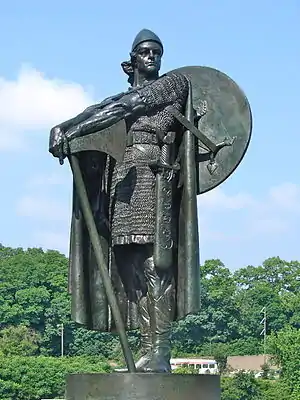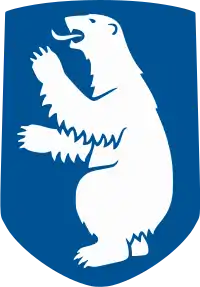Skræling
Skræling (Old Norse and Icelandic: skrælingi, plural skrælingjar) is the name the Norse Greenlanders used for the peoples they encountered in North America and Greenland.[1] In surviving sources, it is first applied to the Thule people, the proto-Inuit group with whom the Norse coexisted in Greenland after about the 13th century. In the sagas, it is also used for the peoples of the region known as Vinland whom the Norse encountered during their expeditions there in the early 11th century.

Etymology
The word is most likely related to the Old Norse word skrá, meaning "dried skin", in reference to the animal pelts worn by the Inuit.[2] William Thalbitzer (1932: 14) speculated that skræling might have been derived from the Old Norse verb skrækja, meaning "bawl, shout, or yell".[3] In modern Icelandic, skrælingi means "barbarian", whereas the Danish descendant, skrælling, means "weakling".
The term is thought to have first been used by Ari Thorgilsson in his work Íslendingabók, also called The Book of the Icelanders,[4] written well after the period in which Norse explorers made their first contacts with indigenous Americans. By the time these sources were recorded, skræling was the common term Norse Greenlanders used for the Thule people, the ancestors to the modern Inuit. The Thule first arrived in Greenland from the North American mainland in the 13th century and were thereafter in contact with the Greenlanders. The Greenlanders' Saga and the Saga of Erik the Red, which were written in the 13th century, use this same term for the people of the area known as Vinland whom the Norse met in the early 11th century. The word subsequently became well known, and has been used in the English language since the 18th century.[5]
"Kalaallit", the name of the largest ethnic group of Greenlandic Inuit, is likely derived from skræling.[3] In 1750, Paul Egede mentions that the Inuit used "Inuit" between themselves, but used Kalaalit when speaking to non-Inuit people, and that they had mentions that this was the term used by Norse settlers.[3]
Norse exploration of the New World
Norse exploration of the New World began with the initial sighting of North America by an Icelander named Bjarni Herjólfsson, who spotted land after drifting off course on a journey to Greenland in 985 or 986.
They speculated among themselves as to what land this would be, for Bjarni said he suspected this was not Greenland.[6]
His voyage piqued the interest of later explorers including Leif Eriksson, who would explore and name the areas of Helluland, Markland and Vinland.
First contact
Eriksson laid the groundwork for later colonizing efforts in the generations to come by establishing a foothold on Vinland, when he constructed some "large houses." Upon his return to Greenland,
There was great discussion of Leif's Vinland voyage, and his brother Thorvald felt they had not explored enough of the land. Leif then told Thorvald, 'You go to Vinland, brother, and take my ship if you wish, but before you do so I want the ship to make a trip to the skerry to fetch the wood that Thorir had there'[6]
Thorvald has the first contact with the native population which would come to be known as the skrælings. After capturing and killing eight of the natives, they were attacked at their beached ships, which they defended:
'I have been wounded under my arm,' he said. 'An arrow flew between the edge of the ship and the shield into my armpit. Here is the arrow, and this wound will cause my death.'[6]
Thorfinn Karlsefni

Thorfinn Karlsefni was the first Norse explorer to attempt to truly colonize the newly discovered land of Vinland on the same site as his predecessors Thorvald and Leif Eriksson. According to the Saga of Erik the Red, he set sail with three ships and 140 men.[7]
Upon reaching Vinland, their intended destination, they found the now famous grapes and self-sown wheat for which the land was named. They spent a very hard winter at this site, where they barely survived by fishing, hunting game inland, and gathering eggs on the island. The following summer they sailed to the island of Hop where they had the first peaceful interactions with the native people, with whom they traded. Karlsefni forbade his men to trade their swords and spears, so they mainly exchanged their red cloth for pelts. Afterwards they were able to describe the aboriginal inhabitants in detail, saying:
They were short in height with threatening features and tangled hair on their heads. Their eyes were large and their cheeks broad.[7]
Shortly thereafter, the Norsemen were attacked by natives who had been frightened by a bull that broke loose from their encampment. They were forced to retreat to an easily defensible location and engage their attackers; at the end of the battle two of his men had been slain, while "many of the natives" were killed. As with anywhere in this foreign land, Karlsefni and his men realized that
despite everything the land had to offer there, they would be under constant threat of attack from its prior inhabitants.[7]
After this adventure, they returned to Greenland. Their three-year excursion would be the longest lasting known European colony in the New World until Columbus's voyages nearly 500 years later initiated full-scale colonization.
Inuit folktales of the Norse
There are also accounts from the Inuit peoples which describe interactions with the Norse:
[S]oon the kayaker sent out his spear in good earnest, and killed him on the spot. When winter came, it was a general belief that the Kavdlunait would come and avenge the death of their countrymen[8]
Kavdlunait (plural) was the Inuit word for foreigner or European, compare modern Greenlandic qallunaaq ("Dane"), formerly spelled ĸavdlunâĸ.
See also
References
- Murrin, John M; Johnson, Paul E; McPherson, James M; Gerstle, Gary (2008). Liberty, Equality, Power: A History of the American People, Compact. Thomson Wadsworth. p. 6. ISBN 978-0-495-41101-7. Retrieved 2010-11-24.
- Ásgeir Blöndal Magnússon (1989). Íslensk orðsifjabók [Icelandic Etymological Dictionary].
- Ernst Hakon Jahr; Ingvild Broch (1 January 1996). Language Contact in the Arctic: Northern Pidgins and Contact Languages. Walter de Gruyter. p. 233. ISBN 978-3-11-081330-2.
- Seaver, Kirsten (2010). The Last Vikings. I.B. Tauris. pp. 62–63. ISBN 978-1845118693.
- "Skraeling". Oxford English Dictionary. June 1989. Retrieved October 12, 2010.
- Keneva Kunz (Translator) The Saga of the Greenlanders, in The Saga of Icelanders (New York: Penguin Books, 2001). ISBN 0-670-88990-3
- Keneva Kunz (Translator) The Saga of Erik the Red, in The Saga of Icelanders, Penguin Books, New York, 2001. ISBN 0-670-88990-3
- Henry Rink Tales and Traditions of the Eskimo (Edinburgh: Blackwood, 1875, p. 310
- Hans Christian Gulløv, ed., Grønlands Forhistorie, Copenhagen: Gyldendal, 2005. ISBN 8702017245
- Magnus Magnusson and Hermann Pálsson (Translators), The Vinland Sagas : The Norse Discovery of America, Penguin Books, 1965 Translation, 13th reprint of 1985, p. 65, ISBN 978-0-14-044154-3
- Kane, Njord (2015) The Vikings: The Story of a People (Spangenhelm Publishing) ISBN 978-1-943066-018
Further reading
- "Skraeling: First Peoples of Helluland, Markland, and Vinland.” Odess, Daniel; Stephen Loring; and William W. Fitzhugh, in Vikings: The North Atlantic Saga. Fitzhugh, William W. and Elisabeth I. Ward, editors. Washington, DC: Smithsonian Institution, 2000. Pages 193–205. ISBN 1-56098-995-5.
- "The Viking discovery of America: the excavation of a Norse settlement in L'Anse aux Meadows, Newfoundland." Ingstad Helge. Checkmark Books. New York, 2001. ISBN 0-8160-4716-2.
- Kane, Njord (2015) The Vikings: The Story of a People (Spangenhelm Publishing) ISBN 978-1-943066-018
- http://blogmeridian.blogspot.com/2008/08/unknowing-world.html
- http://www.newadvent.org/cathen/01416a.htm
- "Norse contact with Native Americans before the Viking Age" by Njord Kane, 2016 * http://spangenhelm.com/norse-contact-native-americans-viking-age/

